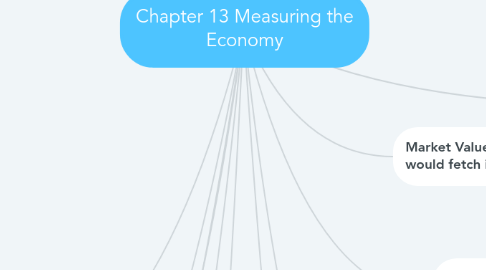Chapter 13 Measuring the Economy
by Carlee Schroeter

1. How do economists measure the size of an economy?
1.1. Economists can look at two different perspectives: Microeconomics and Microeconomics
1.2. Gross Domestic Product(GDP) is the main measure used. GDP is market value of final goods and services that a country makes over a certain period of time.
1.3. Calculation for GDP: C + I + G + NX = GDP
1.4. GDP growth makes people better off by having higher levels of education, higher life expectancy, and lower infant mortality.
2. What Does the Unemployment Rate Tell Us About an Economy’s Health?
2.1. If more people are quitting their jobs to find new ones, it shows a healthy economy because people feel confident enough to be able to find another job.
2.2. If people start keeping their jobs more, then that shows an unhealthy economy because people don't think that they will be able to get another job quickly
2.3. The unemployment rate is measured mostly by people filling out surveys
2.4. The unemployment rate shows a healthy economy if that percent is low. That means that most of that country is working.
3. What Does the Inflation Rate Reveal About an Economy’s Health?
3.1. This is measured by price index, consumer index, and cost-of-living index.
3.2. If the inflation rate is high, then prices are up. Which cause people to not buy as much goods.
3.3. If the inflation rate is low, then the price of goods is low. This causes people to still not buy then because they expect it to lower even more.
3.4. Hyperinflation and deflation are the rise and fall in prices over a certain time.
4. How Does the Business Cycle Relate to Economic Health?
4.1. I was not able to upload a pick of the business cycle.
4.2. The business cycle is made up of peaks and troughs which are the highs and lows of a business.
4.3. It is also made up of contractions and expansions which are the growths and declines in a business.
4.4. This cycle relates to the health of the economy by giving economist something to do. So they predict a businesses cycle and make decisions on what the business should to avoid major contractions. This cycle is hard to predict so they use indicators: GDP, inflation and employment rate.
5. Market Value-The price an asset would fetch in the marketplace
6. Macroeconomics-a branch of the economics field that studies how the aggregate economy behaves.
7. Microecomomics-is a branch of economics that studies the behavior of individuals and firms in making decisions regarding the allocation of scarce resources and the interactions among these individuals and firms.
8. Frictional Unemployment- results from time spent between jobs when a worker is searching for, or transitioning from one job to another.
9. Structural Unemployment-caused by a mismatch between the skills that workers in the economy can offer, and the skills demanded of workers by employers
10. Discouraged Workers- a person of legal employment age who is not actively seeking employment or who does not find employment after long-term unemployment.
11. Real Wages-terms of the amount of goods and services that can be bought.
12. Nominal Wages-the rate of pay employees are compensated.
13. Depression-is a sustained, long-term downturn in economic activity in one or more economies
14. Contraction-occurs after the business cycle peaks but before it becomes a trough


